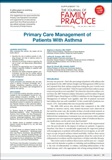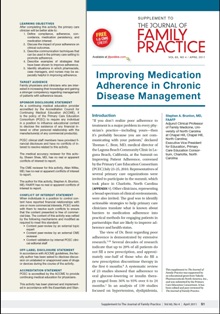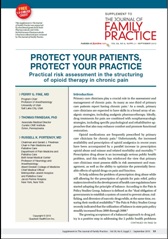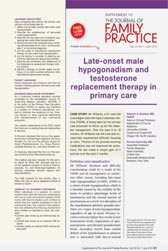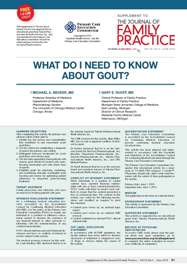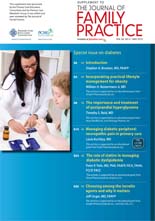User login
Primary Care Management of Patients With Asthma
There has been little improvement in the impact of asthma on patient morbidity and limitations on activity over the past decade, indicating the need for better utilization of existing therapies and improved patient self-management. This CME supplement discusses the role of small-airway inflammation in asthma and its possible relevance in the selection of anti-inflammatory therapy. While anti-inflammatory therapy is the mainstay of treatment for persistent asthma, long-acting ß-agonists (LABAs) are often used inappropriately, which has caused the FDA to take several actions due to safety concerns. While some of these actions have been questioned as inconsistent with current evidence-based guidelines, patient self-management should be reinforced at each patient visit and supported by a written asthma action plan.
There has been little improvement in the impact of asthma on patient morbidity and limitations on activity over the past decade, indicating the need for better utilization of existing therapies and improved patient self-management. This CME supplement discusses the role of small-airway inflammation in asthma and its possible relevance in the selection of anti-inflammatory therapy. While anti-inflammatory therapy is the mainstay of treatment for persistent asthma, long-acting ß-agonists (LABAs) are often used inappropriately, which has caused the FDA to take several actions due to safety concerns. While some of these actions have been questioned as inconsistent with current evidence-based guidelines, patient self-management should be reinforced at each patient visit and supported by a written asthma action plan.
There has been little improvement in the impact of asthma on patient morbidity and limitations on activity over the past decade, indicating the need for better utilization of existing therapies and improved patient self-management. This CME supplement discusses the role of small-airway inflammation in asthma and its possible relevance in the selection of anti-inflammatory therapy. While anti-inflammatory therapy is the mainstay of treatment for persistent asthma, long-acting ß-agonists (LABAs) are often used inappropriately, which has caused the FDA to take several actions due to safety concerns. While some of these actions have been questioned as inconsistent with current evidence-based guidelines, patient self-management should be reinforced at each patient visit and supported by a written asthma action plan.
Improving Medication Adherence in Chronic Disease Management
The magnitude of medication nonadherence and the consequent negative health impact are great and should create a sense of urgency among clinicians to address this serious problem.
The magnitude of medication nonadherence and the consequent negative health impact are great and should create a sense of urgency among clinicians to address this serious problem.
The magnitude of medication nonadherence and the consequent negative health impact are great and should create a sense of urgency among clinicians to address this serious problem.
Protect Your Patients, Protect Your Practice: Practical Risk Assessment in the Structuring of Opioid Therapy in Chronic Pain
Primary care clinicians play a crucial role in the assessment and management of chronic pain. As many as one-third of primary care patients report having chronic pain. As a result, primary care clinicians are expected to have skills in a broad array of analgesic strategies, including analgesic pharmacotherapy. Ideally, drug treatments for pain are combined with nonpharmacologic strategies, including specific psychological and rehabilitative approaches that also may enhance comfort and promote functional restoration.
Primary care clinicians play a crucial role in the assessment and management of chronic pain. As many as one-third of primary care patients report having chronic pain. As a result, primary care clinicians are expected to have skills in a broad array of analgesic strategies, including analgesic pharmacotherapy. Ideally, drug treatments for pain are combined with nonpharmacologic strategies, including specific psychological and rehabilitative approaches that also may enhance comfort and promote functional restoration.
Primary care clinicians play a crucial role in the assessment and management of chronic pain. As many as one-third of primary care patients report having chronic pain. As a result, primary care clinicians are expected to have skills in a broad array of analgesic strategies, including analgesic pharmacotherapy. Ideally, drug treatments for pain are combined with nonpharmacologic strategies, including specific psychological and rehabilitative approaches that also may enhance comfort and promote functional restoration.
Late-onset male hypogonadism and testosterone replacement therapy in primary care
Hypogonadism is a highly prevalent condition that is under-diagnosed and under-treated despite available effective therapies. Low levels of testosterone result in losses of lean body mass and bone mass, decreases in libido and sexual function and is associated with insulin resistance, metabolic syndrome, diabetes, and other chronic comorbid conditions. It is important for physicians to be aware of how testosterone levels can be related to these conditions, which are seen in primary care practices on a daily basis.
This CME supplement discusses the definition, epidemiology and key signs and symptoms of late-onset hypogonadism, the role of lab measurements, factors to consider in selecting patients for testosterone replacement therapy, and how to identify the best treatment strategy for each patient.
Hypogonadism is a highly prevalent condition that is under-diagnosed and under-treated despite available effective therapies. Low levels of testosterone result in losses of lean body mass and bone mass, decreases in libido and sexual function and is associated with insulin resistance, metabolic syndrome, diabetes, and other chronic comorbid conditions. It is important for physicians to be aware of how testosterone levels can be related to these conditions, which are seen in primary care practices on a daily basis.
This CME supplement discusses the definition, epidemiology and key signs and symptoms of late-onset hypogonadism, the role of lab measurements, factors to consider in selecting patients for testosterone replacement therapy, and how to identify the best treatment strategy for each patient.
Hypogonadism is a highly prevalent condition that is under-diagnosed and under-treated despite available effective therapies. Low levels of testosterone result in losses of lean body mass and bone mass, decreases in libido and sexual function and is associated with insulin resistance, metabolic syndrome, diabetes, and other chronic comorbid conditions. It is important for physicians to be aware of how testosterone levels can be related to these conditions, which are seen in primary care practices on a daily basis.
This CME supplement discusses the definition, epidemiology and key signs and symptoms of late-onset hypogonadism, the role of lab measurements, factors to consider in selecting patients for testosterone replacement therapy, and how to identify the best treatment strategy for each patient.
What do I need to know about gout?
Gout is a chronic, often silent disorder in its early stages that is punctuated by acute, extremely painful arthritic flares. Over time, untreated or insufficiently treated gout may progress, with more frequent flares and formation of urate crystal deposits (tophi) and associated chronic, deforming arthritis (gouty arthropathy). One major aim in the management of gout is to treat the pain of acute flares aggressively with anti-inflammatory agents to reduce flare intensity and duration. This CME supplement discusses the risk factors and comorbidities that contribute to and exacerbate acute gout flares, the criteria for establishing a diagnosis of gout and how to establish goals for achieving, sustaining, and monitoring clinically meaningful urate lowering and means for optimizing patient adherence to long-term urate-lowering treatment.
Gout is a chronic, often silent disorder in its early stages that is punctuated by acute, extremely painful arthritic flares. Over time, untreated or insufficiently treated gout may progress, with more frequent flares and formation of urate crystal deposits (tophi) and associated chronic, deforming arthritis (gouty arthropathy). One major aim in the management of gout is to treat the pain of acute flares aggressively with anti-inflammatory agents to reduce flare intensity and duration. This CME supplement discusses the risk factors and comorbidities that contribute to and exacerbate acute gout flares, the criteria for establishing a diagnosis of gout and how to establish goals for achieving, sustaining, and monitoring clinically meaningful urate lowering and means for optimizing patient adherence to long-term urate-lowering treatment.
Gout is a chronic, often silent disorder in its early stages that is punctuated by acute, extremely painful arthritic flares. Over time, untreated or insufficiently treated gout may progress, with more frequent flares and formation of urate crystal deposits (tophi) and associated chronic, deforming arthritis (gouty arthropathy). One major aim in the management of gout is to treat the pain of acute flares aggressively with anti-inflammatory agents to reduce flare intensity and duration. This CME supplement discusses the risk factors and comorbidities that contribute to and exacerbate acute gout flares, the criteria for establishing a diagnosis of gout and how to establish goals for achieving, sustaining, and monitoring clinically meaningful urate lowering and means for optimizing patient adherence to long-term urate-lowering treatment.
Special Issue on Diabetes
As the prevalence of type 2 diabetes mellitus (T2DM) rises, primary care physicians must be prepared to manage this disease. In this supplement, 5 key topics related to T2DM are discussed—obesity, postprandial glucose, diabetic peripheral neuropathic pain, dyslipidemia, and the incretins.
As the prevalence of type 2 diabetes mellitus (T2DM) rises, primary care physicians must be prepared to manage this disease. In this supplement, 5 key topics related to T2DM are discussed—obesity, postprandial glucose, diabetic peripheral neuropathic pain, dyslipidemia, and the incretins.
As the prevalence of type 2 diabetes mellitus (T2DM) rises, primary care physicians must be prepared to manage this disease. In this supplement, 5 key topics related to T2DM are discussed—obesity, postprandial glucose, diabetic peripheral neuropathic pain, dyslipidemia, and the incretins.
The dawn of a new era: Transforming our domestic response to hepatitis B & C
Our understanding of chronic hepatitis B virus (HBV) and hepatitis C virus (HCV) infections has improved in recent years. Safe and effective vaccines for HBV as well as effective antiviral therapies for HBV and HCV infections are now available. However, current approaches to the prevention and control of chronic HBV and HCV infections have fallen short, resulting in a major public health problem. The prevalence of chronic HBV and HCV infections is expected to increase in the United States, as is the burden of hepatitis-associated cirrhosis, end-stage liver disease, and liver cancer. The time to develop new strategies to prevent, screen, and treat chronic viral hepatitis is now.
Our understanding of chronic hepatitis B virus (HBV) and hepatitis C virus (HCV) infections has improved in recent years. Safe and effective vaccines for HBV as well as effective antiviral therapies for HBV and HCV infections are now available. However, current approaches to the prevention and control of chronic HBV and HCV infections have fallen short, resulting in a major public health problem. The prevalence of chronic HBV and HCV infections is expected to increase in the United States, as is the burden of hepatitis-associated cirrhosis, end-stage liver disease, and liver cancer. The time to develop new strategies to prevent, screen, and treat chronic viral hepatitis is now.
Our understanding of chronic hepatitis B virus (HBV) and hepatitis C virus (HCV) infections has improved in recent years. Safe and effective vaccines for HBV as well as effective antiviral therapies for HBV and HCV infections are now available. However, current approaches to the prevention and control of chronic HBV and HCV infections have fallen short, resulting in a major public health problem. The prevalence of chronic HBV and HCV infections is expected to increase in the United States, as is the burden of hepatitis-associated cirrhosis, end-stage liver disease, and liver cancer. The time to develop new strategies to prevent, screen, and treat chronic viral hepatitis is now.
